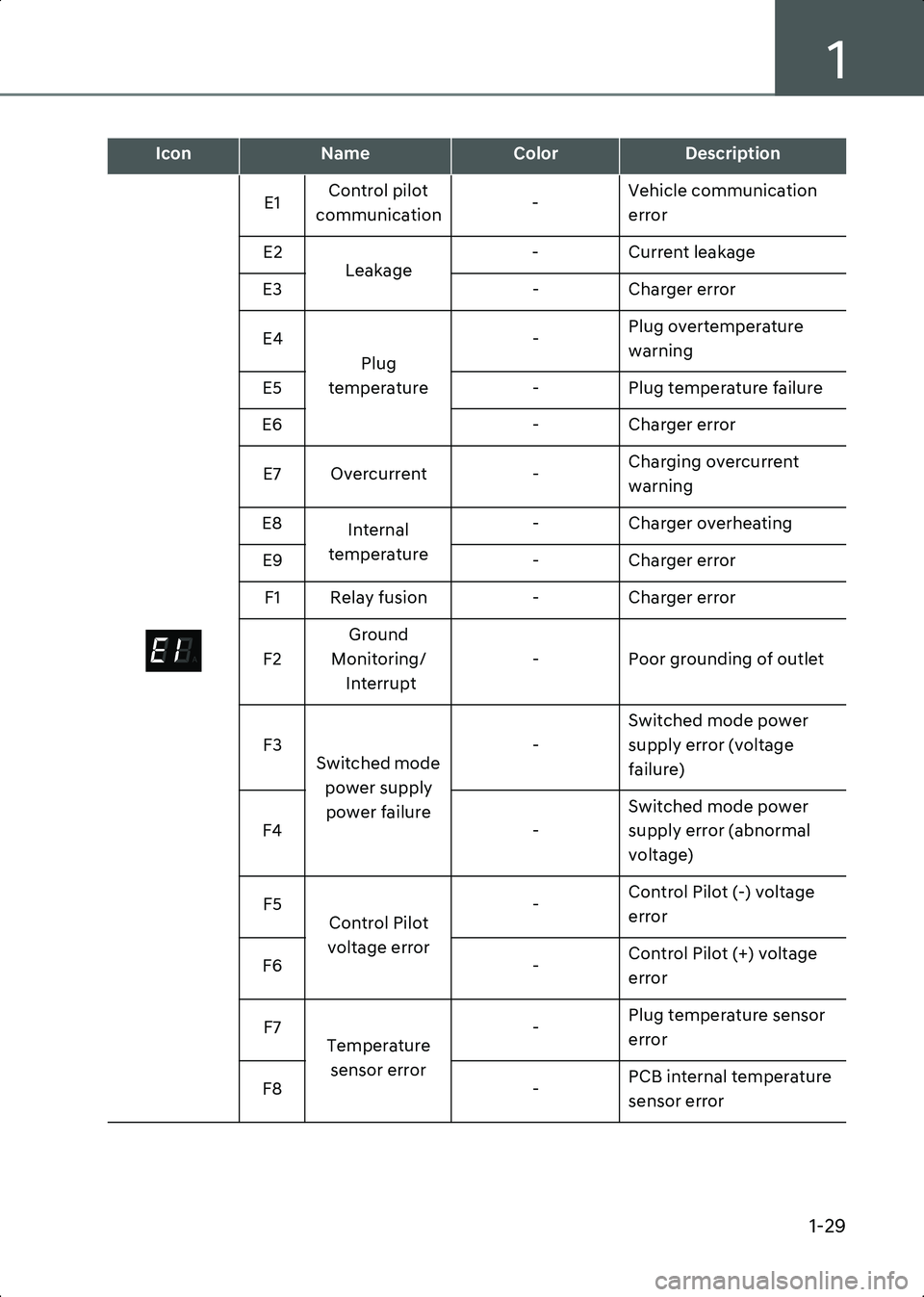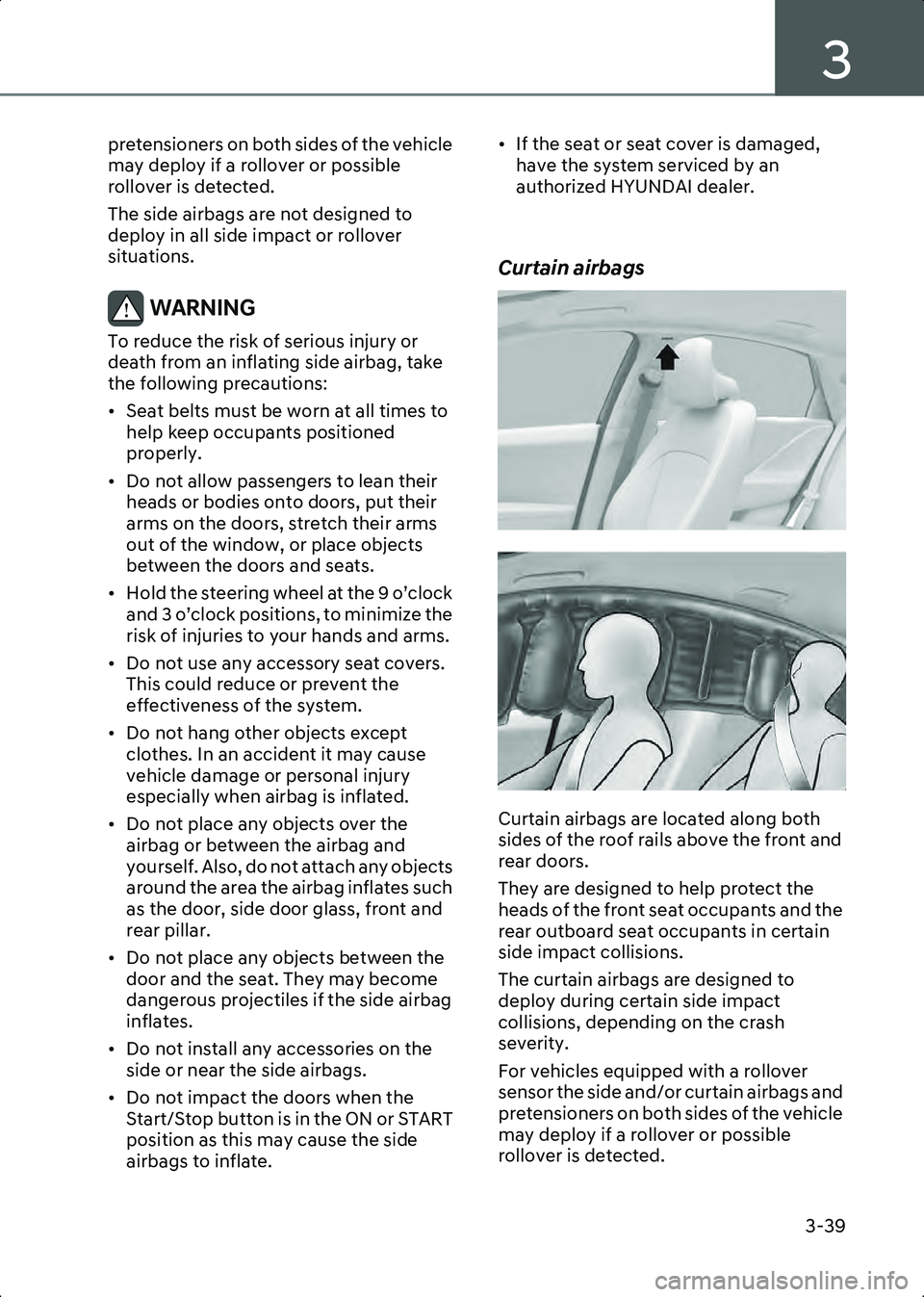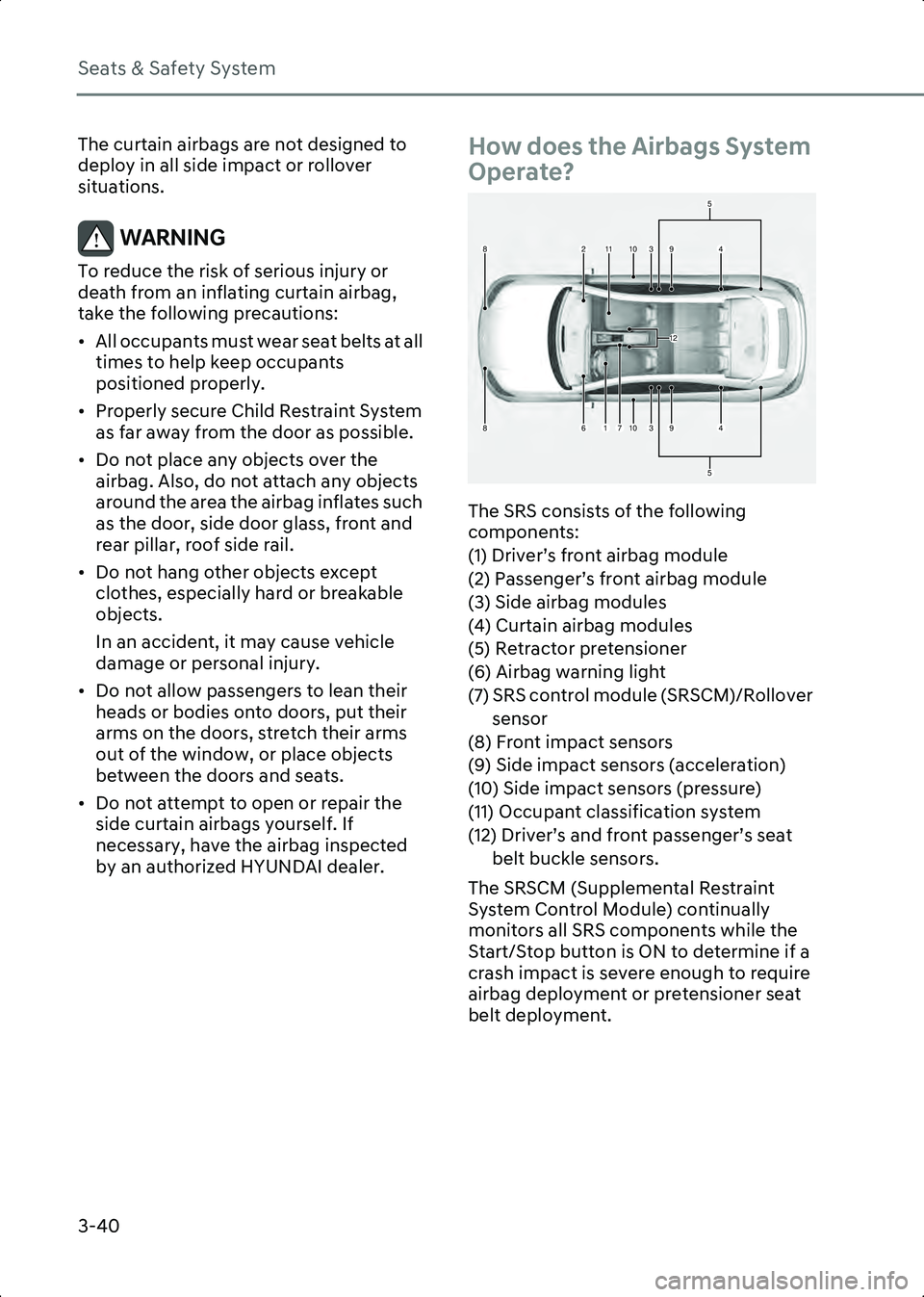2023 HYUNDAI IONIQ 6 sensor
[x] Cancel search: sensorPage 16 of 582

Introduction/Getting Started with Your Electric Vehicle
1-10
•Vehicle Control Unit (VCU) : Controls the various controllers and sensors on the
vehicle.
• Motor : Uses electricity accumulated on the high voltage battery to drive the vehicle
(same role as an engine in gasoline vehicles).
• Gear: Delivers the rotational force of the motor to the tires at appropriate speeds and
torque.
• High voltage battery (Lithium-ion battery) : Stores and supplies power necessary for
the electric vehicle to operate. (The separately installed 12 V battery provides power to
the vehicle when the vehicle is in ACC or OFF.)
WARNING • Do not remove or disassemble any high voltage battery’s connectors and wires. Doing so may lead to accidents, such as electric shock, and result in serious injury and
significantly degrade the vehicle’s performance and durability.
• When the high voltage battery or its related components require inspection and maintenance, contact an authorized HYUNDAI dealer.
Precautions When Using the High Voltage Battery
Precautions for high voltage battery when driving and storing the vehicle are as follows:
CAUTION • Keep the gauge of the high voltage battery from going below 10 %. Storing the vehicle while the battery level is too low for a long time may damage the battery or reduce the
battery’s capacity.
• If a collision occurs and the vehicle is impacted, have the vehicle inspected by an authorized HYUNDAI dealer and check the battery connection status.
• Using the V2L function may reduce the driving distance due to the use of high voltage battery energy, and repeated use of the V2L function may impact battery life.
• Frequent use of DC charging may impact battery life.
• The high voltage battery level may reduce naturally even if the vehicle is not driven.
• Storing the vehicle in temperatures that are too hot or cold may degrade the battery performance.
• The distance to empty or power output may vary depending on the driving conditions, such as the outside temperature. Driving on highway at high speeds or uphill will
increase battery consumption, resulting in a shorter distance to empty.
• If you use the air conditioner or heater, which is powered by the high voltage battery, the distance to empty will be reduced. Maintain reasonable temperature when using
the air conditioner or heater to maximize distance to empty.
• Depending on the vehicle’s period of use, natural degradation of the battery may occur that reduces distance to empty over long period of vehicle life. When the charge
Hyundai_CE_en_US.book Page 10
Page 35 of 582

1
1-29
E1Control pilot
communication -Vehicle communication
error
E2 Leakage - Current leakage
E3 - Charger error
E4 Plug
temperature -
Plug overtemperature
warning
E5 - Plug temperature failure
E6 - Charger error
E7 Overcurrent -Charging overcurrent
warning
E8 Internal
temperature - Charger overheating
E9 - Charger error
F1 Relay fusion - Charger error
F2 Ground
Monitoring/ Interrupt - Poor grounding of outlet
F3 Switched mode
power supply power failure -
Switched mode power
supply error (voltage
failure)
F4 -Switched mode power
supply error (abnormal
voltage)
F5 Control Pilot
voltage error -
Control Pilot (-) voltage
error
F6 -Control Pilot (+) voltage
error
F7 Temperature
sensor error -
Plug temperature sensor
error
F8 -PCB internal temperature
sensor error
IconNameColorDescription
A
Hyundai_CE_en_US.book Page 29
Page 65 of 582

1
1-59
Checking the warning lights
Check the cause of the warning lights referring to the table below and take appropriate
measures.
Warning LightCauseMeasure
Service warning light This warning light illuminates:
• When there is a problem with
related parts of the electric
vehicle control system, such
as sensors, etc.
• When an actuator, electric compressor for air
conditioning, etc.
malfunctions. In a normal condition, it
illuminates for about 3 seconds
when the Start/Stop button is in
the ON position and then goes
off.
• When the warning light
illuminates while driving, or
does not go off after starting
the vehicle, have your vehicle
inspected by an authorized
HYUNDAI dealer.
Power down indicator light This warning light illuminates:
• When the high voltage
battery level is too low or
voltage is decreasing.
(Output limit occurs when the
charge level is insufficient.)
• When the temperature of the high voltage battery is too
high or too low.
• When the driving system temperature is overheated
and requires protection. If it illuminates alone, it is not
failure.
• If both Power down indicator
light and Service warning
light illuminate at the same
time, have the vehicle
inspected by an authorized
HYUNDAI dealer.
• When the indicator is illuminating, immediately
charge the vehicle. The
driving speed may be limited
and the vehicle may not
properly drive uphill.
High voltage battery level warning light This warning light illuminates
when the high voltage battery
level is low. Immediately charge the
vehicle. The vehicle can drive
an additional 18-31 mi. (30-50
km).
• The actual distance to empty
depends on the driving
conditions.
Regenerative brake warning light This warning light illuminates
when the regenerative brake
does not operate and the brake
does not perform well due to
the malfunction of the brake
system. Drive safely and have your
vehicle inspected by an
authorized HYUNDAI dealer.
• The operation of the brake
pedal may feel deeper than
normal or the braking
distance may increase.
Hyundai_CE_en_US.book Page 59
Page 131 of 582

3
3-37
WARNING AIRBAG SAFETY PRECAUTIONS
ALWAYS use seat belts and Child
Restraint Systems - every trip, every time,
everyone! Even with airbags, you can be
seriously injured or killed in a collision if
you are improperly belted or not wearing
your seat belt when the airbag inflates.
NEVER place a child in any Child Restraint
System or booster seat in the front
passenger seat, unless the airbag is
deactivated.
An inflating airbag could forcefully strike
the infant or child causing serious or fatal
injuries.
ABC - Always Buckle Children under age
13 in the back seat. It is the safest place for
children of any age to ride. If a child age 13
or older must be seated in the front seat,
he or she must be properly belted and the
seat should be moved as far back as
possible.
All occupants should sit upright with the
seatback in an upright position, centered
on the seat cushion with their seat belt on,
legs comfortably extended and their feet
on the floor until the vehicle is parked and
the vehicle is turned off. If an occupant is
out of position during an accident, the
rapidly deploying airbag may forcefully
contact the occupant causing serious or
fatal injuries.
You and your passengers should never sit
or lean unnecessarily close to the airbags
or lean against the door or center console.
Move your seat as far back as possible
from front airbags, while still maintaining
control of the vehicle. The U.S. National
Highway Traffic Safety Administration
(NHTSA) recommends that drivers allow
at least 10 in. (25 cm) between the center
of the steering wheel and the chest.
Where are the Airbags?
Driver’s and passenger’s front
airbags
Driver’s front airbag
B3002801Passenger’s front airbag
B3003001
Your vehicle is equipped with a
Supplemental Restraint System (SRS) and
lap/shoulder belts at both the driver and
passenger seating positions.
The SRS consists of airbags which are
located in the center of the steering
wheel and the passenger’s side front
panel pad above the glove box.
The airbags are labeled with the letters
“AIRBAG” embossed on the pad covers.
The purpose of the SRS is to provide the
vehicle’s driver and front passengers with
additional protection than that offered by
the seat belt system alone in case of a
frontal impact of sufficient severity.
The seat belt buckle sensors determine if
the driver and front passenger's seat belts
are fastened. These sensors provide the
Hyundai_CE_en_US.book Page 37
Page 132 of 582

Seats & Safety System
3-38
ability to control the SRS deployment
based on whether or not the seat belts are
fastened, and how severe the impact is.
The advanced SRS offers the ability to
control the airbag inflation within two
levels. A first stage level is provided for
moderate-severity impacts. A second
stage level is provided for more severe
impacts.
According to the impact severity, and
seat belt usage, the SRS Control Module
(SRSCM) controls the airbag inflation.
Failure to properly wear seat belts can
increase the risk or severity of injury in an
accident.
WARNING To reduce the risk of serious injury or
death from inflating front airbags, take
the following precautions:
• Seat belts must be worn at all times to help keep occupants positioned
properly.
• Move your seat as far back as possible from front airbags, while still
maintaining control of the vehicle.
• Never lean against the door or center console.
• Do not allow the front passenger to place their feet or legs on the
dashboard.
• Never place any objects (such as dashboard cover, mobile phone holder,
cup holder, perfume or stickers) over or
near the airbag modules on the steering
wheel, instrument panel, windshield
glass, and the front passenger’s panel
above the glove box. Such objects may
cause harm if the vehicle is in a collision
severe enough to cause the airbags to
deploy.
• Do not attach any objects on the front windshield and inside mirror.
Side airbags
Side airbag
B3003202
B3003203
Your vehicle is equipped with a side
airbag in each front seat. The purpose of
the airbag is to provide the vehicle’s
driver and the front passenger with
additional protection than that offered by
the seat belt alone.
The side airbags are designed to deploy
during certain side impact collisions,
depending on the crash severity, angle,
speed and point of impact.
The side airbags on both sides of the
vehicle are designed to deploy when a
rollover is detected by a rollover sensor.
(if equipped with rollover sensor)
The side airbags are not designed to
deploy in all side impact or rollover
situations.
The side airbags are designed to deploy
during certain side impact collisions,
depending on the crash severity.
For vehicles equipped with a rollover
sensor the side and/or curtain airbags and
Hyundai_CE_en_US.book Page 38
Page 133 of 582

3
3-39
pretensioners on both sides of the vehicle
may deploy if a rollover or possible
rollover is detected.
The side airbags are not designed to
deploy in all side impact or rollover
situations.
WARNING To reduce the risk of serious injury or
death from an inflating side airbag, take
the following precautions:
• Seat belts must be worn at all times to help keep occupants positioned
properly.
• Do not allow passengers to lean their heads or bodies onto doors, put their
arms on the doors, stretch their arms
out of the window, or place objects
between the doors and seats.
• Hold the steering wheel at the 9 o’clock and 3 o’clock positions, to minimize the
risk of injuries to your hands and arms.
• Do not use any accessory seat covers. This could reduce or prevent the
effectiveness of the system.
• Do not hang other objects except clothes. In an accident it may cause
vehicle damage or personal injury
especially when airbag is inflated.
• Do not place any objects over the airbag or between the airbag and
yourself. Also, do not attach any objects
around the area the airbag inflates such
as the door, side door glass, front and
rear pillar.
• Do not place any objects between the door and the seat. They may become
dangerous projectiles if the side airbag
inflates.
• Do not install any accessories on the side or near the side airbags.
• Do not impact the doors when the Start/Stop button is in the ON or START
position as this may cause the side
airbags to inflate. • If the seat or seat cover is damaged,
have the system serviced by an
authorized HYUNDAI dealer.
Curtain airbags
B3003301
B3003302
Curtain airbags are located along both
sides of the roof rails above the front and
rear doors.
They are designed to help protect the
heads of the front seat occupants and the
rear outboard seat occupants in certain
side impact collisions.
The curtain airbags are designed to
deploy during certain side impact
collisions, depending on the crash
severity.
For vehicles equipped with a rollover
sensor the side and/or curtain airbags and
pretensioners on both sides of the vehicle
may deploy if a rollover or possible
rollover is detected.
Hyundai_CE_en_US.book Page 39
Page 134 of 582

Seats & Safety System
3-40
The curtain airbags are not designed to
deploy in all side impact or rollover
situations.
WARNING To reduce the risk of serious injury or
death from an inflating curtain airbag,
take the following precautions:
• All occupants must wear seat belts at all times to help keep occupants
positioned properly.
• Properly secure Child Restraint System as far away from the door as possible.
• Do not place any objects over the airbag. Also, do not attach any objects
around the area the airbag inflates such
as the door, side door glass, front and
rear pillar, roof side rail.
• Do not hang other objects except clothes, especially hard or breakable
objects.
In an accident, it may cause vehicle
damage or personal injury.
• Do not allow passengers to lean their heads or bodies onto doors, put their
arms on the doors, stretch their arms
out of the window, or place objects
between the doors and seats.
• Do not attempt to open or repair the side curtain airbags yourself. If
necessary, have the airbag inspected
by an authorized HYUNDAI dealer.
How does the Airbags System
Operate?
A3002401
The SRS consists of the following
components:
(1) Driver’s front airbag module
(2) Passenger’s front airbag module
(3) Side airbag modules
(4) Curtain airbag modules
(5) Retractor pretensioner
(6) Airbag warning light
(7) SRS control module (SRSCM)/Rollover sensor
(8) Front impact sensors
(9) Side impact sensors (acceleration)
(10) Side impact sensors (pressure)
(11) Occupant classification system
(12) Driver’s and front passenger’s seat belt buckle sensors.
The SRSCM (Supplemental Restraint
System Control Module) continually
monitors all SRS components while the
Start/Stop button is ON to determine if a
crash impact is severe enough to require
airbag deployment or pretensioner seat
belt deployment.
4
5
5
11
1
23
37
8
86
9
49
10
10
12
Hyundai_CE_en_US.book Page 40
Page 135 of 582

3
3-41
SRS warning light
B3002501
The SRS (Supplemental Restraint System)
airbag warning light on the instrument
cluster the airbag symbol depicted in the
illustration. The system checks the airbag
electrical system for malfunctions. The
light indicates that there is a potential
problem with your airbag system, which
could include your side and/or curtain
airbags used for rollover protection.
WARNING If your SRS malfunctions, the airbag may
not inflate properly during an accident
increasing the risk of serious injury or
death.
If any of the following conditions occur,
your SRS is malfunctioning:
• The light does not turn on for about 3-6 seconds when the Start/Stop button is
in the ON position.
• The light stays on after illuminating for about three to 6 seconds.
• The light comes on while the vehicle is in motion.
• The light blinks when the (ready indicator) is displayed on the
instrument cluster.
Have an authorized HYUNDAI dealer
inspect the SRS as soon as possible if any
of these conditions occur.
During a moderate to severe frontal
collision, sensors will detect the vehicle’s
rapid deceleration. If the rate of
deceleration is high enough, the control
unit will inflate the front airbags, at the
time and with the force needed.
The front airbags help protect the driver
and front passenger by responding to
frontal impacts in which seat belts alone
cannot provide adequate restraint. When
needed, the side airbags help provide
protection in the event of a side impact or
rollover by supporting the side upper
body area.
• Airbags are activated (able to inflate if
necessary) only when the Start/Stop
button is in the ON or START position,
and it can be activated within about 3
minutes after the vehicle is turned off.
• Airbags inflate in the event of certain frontal or side collisions to help protect
the occupants from serious physical
injury.
• Generally, airbags are designed to inflate based upon the severity of a
collision, its direction, or etc. These two
factors determine whether the sensors
produce an electronic
deployment/inflation signal.
• The front airbags will completely inflate and deflate in an instant. It is virtually
impossible for you to see the airbags
inflate during an accident. It is much
more likely that you will simply see the
deflated airbags hanging out of their
storage compartments after the
collision.
• In addition to inflating in serious side collisions, vehicles equipped with a
rollover sensor, side and/or curtain
airbags will inflate if the sensing system
detects a rollover.
When a rollover is detected, curtain
airbags will remain inflated longer to
help provide protection from ejection,
especially when used in conjunction
with the seat belts. (if equipped with a
rollover sensor)
Hyundai_CE_en_US.book Page 41